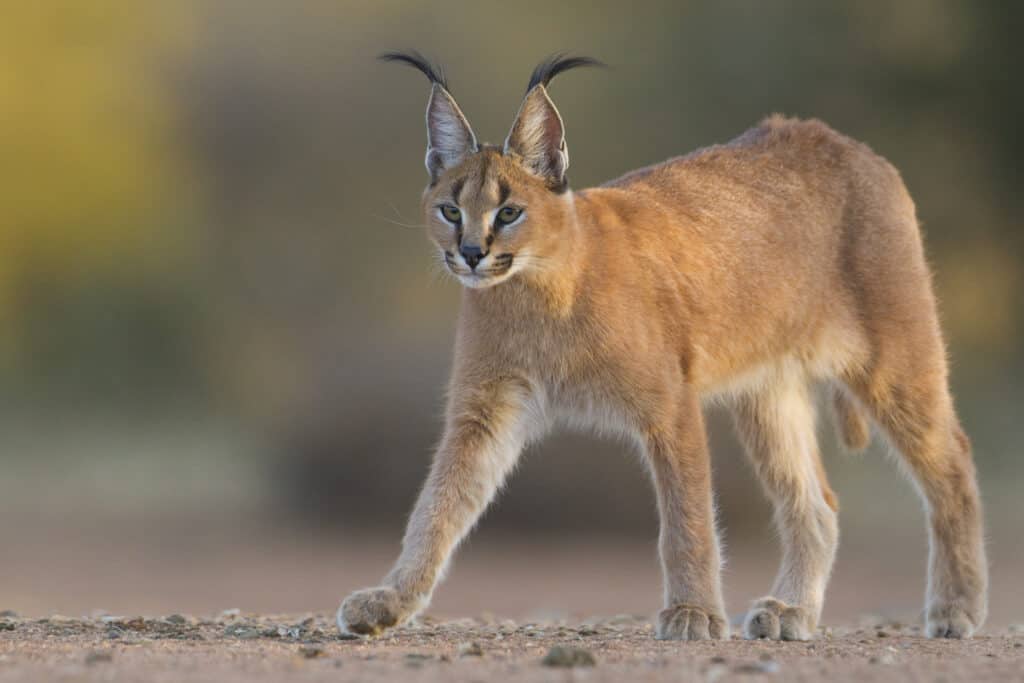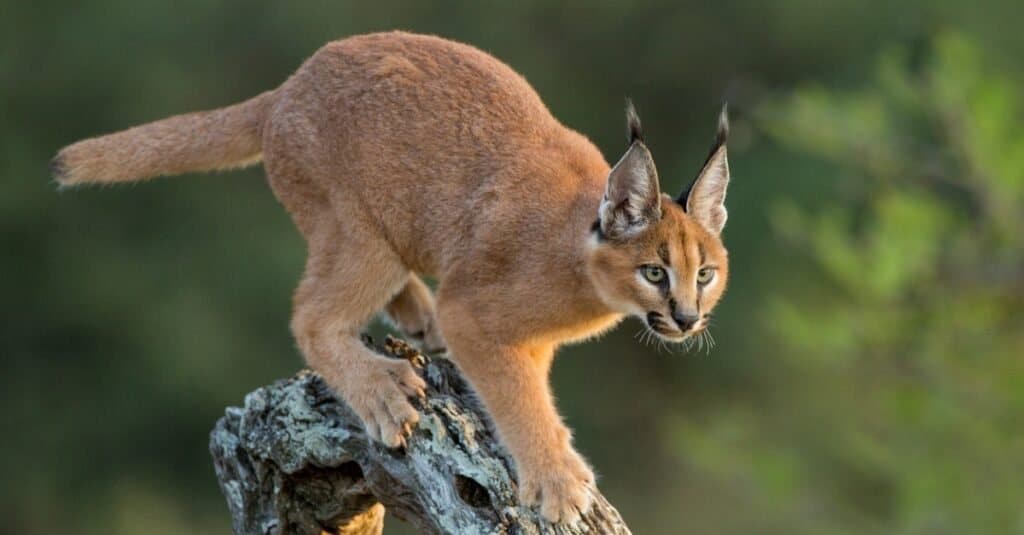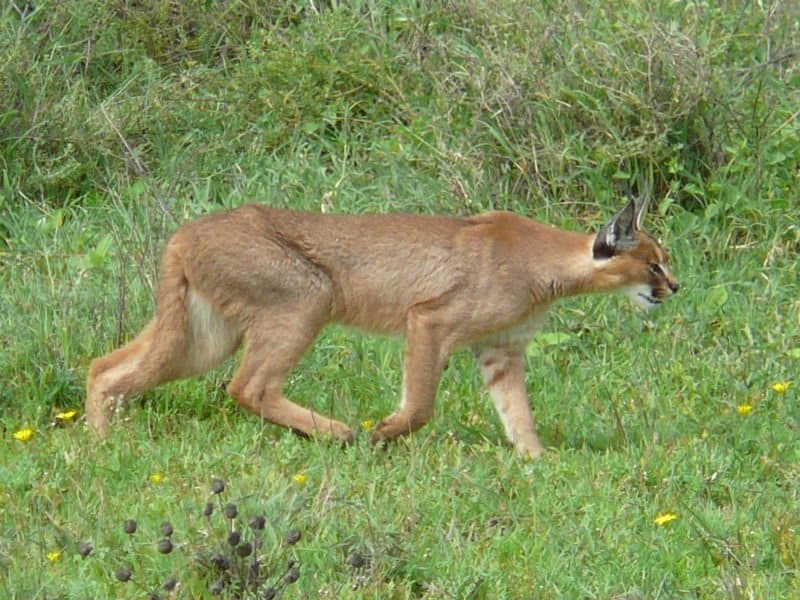If the caracal sounds unfamiliar, think of the wild cats with large black ear tufts on the outside of the lobe. Their name even comes from a Turkic word for “black ears.” While there is little quantified data on the detailed development of this curious-looking cat, there is enough info to give pet owners (where it is legal, see below) an idea of what to expect. How big are caracals cats? Interestingly, they’re considered the biggest of small African cats. They’re also stunning athletes and have other exciting traits.
Summary of Caracal Cats

This young Caracal in South
Africa
is taking a stroll.
©iStock.com/StuPorts
The caracal cat or Caracal caracal (caracal² maybe?) is not a giant cat but it’s still big. How big are caracal cats? They’re about 50% larger—but heavier and more muscular—than a full-grown house cat. They have reddish, wheat-colored fur with a bright white underside and dark-spotted muzzle. Even without the signature antenna-like tufts of black hair, they have large, tall ears.
They inhabit the west coast and southern tip of Africa, plus a wide stripe through the middle of the continent. Other areas include the coasts of Northwest Africa and the Arabian peninsula. They’re also found in parts of the Eurasian Steppes, Iran, India and nearby spots. They prefer dry but forested regions and are not scared of a bit of terrain.
While they have habitats that include a lot of coasts, they apparently prefer moderately higher elevations. This makes sense as they like drier places.
Their diet is mostly smaller mammals, but they are not scared to punch—or jump—above their weight. Ostriches, monkeys, antelopes, and impalas are common targets for these high jumpers. Where the house cat might spring up onto the pantry cabinet from a standstill, the caracal cat can launch up to ten feet high. That’s more than twice their overall length, tail included!
How Big Are Caracal Cats? Rundown

This is a caracal walking down a tree in the afternoon sun in South Africa. These wild cats are easy to identify because of their unusual ears with long, hairy tufts.
©iStock.com/StuPorts
Little publicly available data exists on the specific growth rate of caracals. That’s also the case for their only close relative, the serval. But, there is enough information on the study of various felines—large, small, wild, domesticated—to give a good picture.
Caracal Size at a Glance
- A full-grown caracal has a wide range of weights; they can weigh 20 to 40 lbs (9.1 to 18.2 kg), with the female caracals being much smaller
- To the shoulder, they are around 17 to 19 inches (43 to 48 cm) high when fully grown
- Newborn caracal kittens weigh 8.8 ounces (250 g) and are small enough to hold in one hand
Fully grown, these large felines are about three times the weight of a beefy domestic cat.
Caracal Cat Chart, Approximate Growth & Weight by Age
| Age | Male | Female |
|---|---|---|
| Birth | about 9 oz | about 8.5 oz |
| 1 month | 5 – 7 pounds | 4 – 6 pounds |
| 2 months* | 7 – 10 pounds | 6 – 9 pounds |
| 3 months | 10.5 – 12.5 pounds | 9 – 11 pounds |
| 4 months | 12.5 – 14.5 pounds | 11 – 13 pounds |
| 5 months | 14.5 – 16.5 pounds | 13 – 15 pounds |
| 6 months | 16.5 – 18.5 pounds | 15 – 17 pounds |
| 7 months | 18.5 – 20.5 pounds | 17 – 19 pounds |
| 8 months | 20.5 – 22.5 pounds | 19 – 21 pounds |
| 9 months | 22.5 – 24.5 pounds | 21 – 23 pounds |
| 10 months** | 24.5 – 26.5 pounds | 23 – 25 pounds |
| 11 months | 26.5 – 28 pounds | 25 to 26.5 pounds |
| 12 months | 28 – 30.5 pounds | 26.5 – 28 pounds |
| 13 months | 30.5 – 32 pounds | 28 – 29.5 pounds |
| 14 month | 32 – 33.5 pounds | 29.5 – 31 pounds |
| 15 months | 33.5 – 35 pounds | 31 – 32.5 pounds |
| * stops nursing at 10 weeks and starts eating meat soon after ** early adult; growth slows slightly | – | – |
Caraval Cats as Pets – Check Local Laws
According to Big Cat Rescue, in the United States, each state has specific laws regarding exotic cats. Only Washington, Oregon, Alaska and Louisiana have an outright ban on all private possession of larger and/or exotic felines. And, it depends on the type of cat, from lion to ocelot to many others.
All states except Nevada, North Carolina, Alabama and Wisconsin have added conditions, licensing, etc. How big are caracal cats, lions, leopards, tigers and related cats? That’s a big factor in determining the laws.
How Big Are Caracal Cats and When They Stop Growing?
For those considering caracal kittens as pets, the question is probably how big are caracal cats when they stop growing? They can get up to 40 pounds. That’s almost three times the weight of a full-grown male house cat. At 35 to 40 inches long (with tail) and averaging 17 inches high at the shoulder, the dog-sized pet door and accessories might be in order.
Caraval Cat’s Eating habits

A caracal in the Serengeti; these felines mostly hunt by stalking.
Though caravals have been trained in parts of India and Iran to hunt birds, this is still a largely undomesticated species. In the wild, these felines can even take down small deer—if they get the drop on them (being cats, they stalk their prey). They go for high protein. A curious habit is that, according to the Smithsonian National Zoo, wild caracals will stash their prey/meals and come back for them later.
On a related note, zoo lions have interesting growth tendencies regarding their diet. According to one study, this second cousin to the caracal can grow faster in captivity as there is more food and less competition. Something to keep in mind for caracal ownership.
Thank you for reading! Have some feedback for us? Contact the AZ Animals editorial team.








